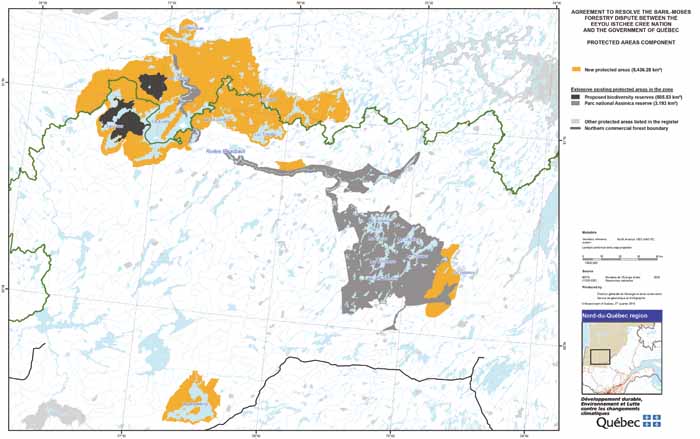
Yellow areas on this map indicate lands that will now be protected from forestry and development under the new Cree-Quebec agreement.
A nation-to-nation forestry agreement has led the Grand Council of the Crees to shelve a multimillion-dollar lawsuit against the Quebec government, but not all Crees are satisfied with the terms reached by the two parties.
Signed on July 12 in Quebec City by Grand Chief Matthew Coon Come and Premier Philippe Couillard, the agreement puts an end to a years-long dispute over controversial forestry practices east of Mistissini and Oujé-Bougoumou.
The Grand Council accused the government of unlawfully authorizing in 2010 clear-cutting on a 7245-square-kilometre parcel of land that is home to 14 Cree traplines. Those traditional hunting grounds were supposed to fall under the protection of the 2002 Baril-Moses Agreement.
Under the new agreement, the Baril-Moses forestry standards will be restored in that territory for the next five years. This means Cree hunting, fishing and wildlife habitat will be protected during that time. After that a new forestry plan – to be devised by a task force made up of Cree, Innu and Quebec government representatives – will be implemented in 2020.
“We are taking yet another significant step today in the nation-to-nation relations between Quebec and the Cree,” said Couillard at the signing. “To ensure sustainable northern development, our priorities must include environmental protection throughout our territory, including the protection of forests and the preservation of endangered species such as the woodland caribou.”
The agreement will also create a new framework for the preservation of boreal forests in the Broadback region that protects the threatened woodland caribou. A 9135-square-km area around the Broadback River is to be designated as a protected area, where forestry of any kind is not permitted.
While Crees in Mistissini and Oujé-Bougoumou celebrated protection for the Baril-Moses forests, community members in Waswanipi maintain that the agreement – specifically the new protection in the Broadback area – doesn’t go far enough.
Already several years into a struggle to increase protection in the Broadback Valley, the Waswanipi council had tabled a request to the Cree Nation Government that their campaign not be included in the new agreement. They were informed that this was not possible. Now, the agreement has been signed and the council says community members are not satisfied with the protected area’s location, which is further north than they had hoped.
“We wanted to ensure the protection of the entire Broadback River Valley, both the north and the south,” said Waswanipi Deputy Chief Mandy Gull. “A lot of the northern protected areas are quite a distance away from the Broadback Valley. Some of the areas that were protected weren’t requested, and important southern areas are left open and vulnerable.”
Gull noted that roughly half of the 9135-square-km protected zone is located above the northern commercial forest boundary, meaning those areas were already protected from forest development. Gull says the southern regions of the Broadback that have been left unprotected are also more vulnerable to mining exploration than the northern regions because they are more accessible.
In a possible attempt to ease Waswanipi’s concerns, the newly signed agreement includes a joint letter from Couillard offering “meaningful discussions” with the Grand Council on further protection status in the Broadback area. Gull says people in her community remain sceptical.
“Complete protection was our first goal,” said Gull. “This agreement only gives us a part of that. We support the recognition that Mistissini and Oujé-Bougoumou gained. Clear-cutting is not conducive to the Cree way of life and there is no community that should have their traplines subject to it. That being said, our community members felt that the protected areas in the Broadback should have been a separate issue from the Baril-Moses dispute.”
But Coon Come describes the agreement as more of a beginning than an end. In an email to the Nation, he explained the Cree Government’s position on the Broadback dispute.
“The Broadback River protected area was a particularly difficult issue, and the object of hard negotiations,” said Coon Come. “We were unable to secure all the protected area desired by the Cree communities. However, we were able to ensure protection for more than 9000-square-kilometres, including certain priority areas. Without this agreement, we would not have achieved anything close to that.”
Coon Come also called attention to new processes in the agreement that will advance Cree interests on many sensitive topics, including forestry.
“The participation of the Chief and Council of Waswanipi will be essential for this work to take proper account of the needs and interests of the Waswanipi tallymen and trappers concerned,” he said. “I have therefore invited them to take part in this important work.”
Coon Come is scheduled to meet with Waswanipi’s band council and interested tallymen July 20 to discuss the agreement.

